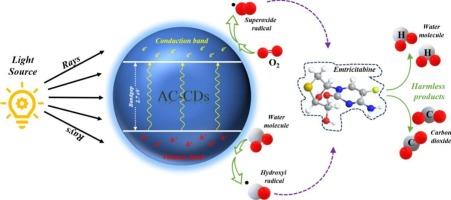从苋菜中提取的可持续溶剂工程碳点用于光催化抗逆转录病毒药物降解和防伪应用的安全油墨中的发光基团
IF 5.1
3区 材料科学
Q2 MATERIALS SCIENCE, COATINGS & FILMS
引用次数: 0
摘要
核苷类逆转录酶抑制剂恩曲他滨(ETB)引起了环境问题,特别是在传统的废水处理设施中其去除率较差。光催化降解是一种很有前途的通过高级氧化过程分解有机药物的技术。本研究探讨了生态可持续苋菜衍生碳点(AC-CDs)作为光活化光催化剂在减少抗逆转录病毒ETB中的应用,强调了一种更具弹性和环保意识的方法。为了诱导AC-CDs的形成,我们特别选择了Amaranthus campestris作为碳源,它在短紫外和长紫外照射下都表现出可调节的发光。合成的AC-CDs量子产率为21.5%,可作为防伪荧光油墨。在最佳条件下,光催化降解ETB的效率在75 min内达到55%。降解的动力学行为符合准一级反应,其速率常数为0.01029 min−1。清除剂研究的结果表明,羟基自由基和孔洞显著有助于药物的减少。这项研究表明,生态可持续衍生的交流- cds为减少水环境中的ETBs提供了一种可行的替代方法,对废水管理和防伪应用的更广泛应用具有潜在的影响。本文章由计算机程序翻译,如有差异,请以英文原文为准。

Sustainable solvent-engineered carbon dots derived from Amaranthus campestris for photocatalytic antiretroviral drug degradation and luminophores in security inks for anti-counterfeit applications
Environmental issues are raised by the nucleoside reverse transcriptase inhibitor medicine emtricitabine (ETB), especially associated with its poor removal efficiency in traditional wastewater treatment facilities. Photocatalytic degradation presents itself as a promising technology for the breakdown of organic pharmaceuticals through the advanced oxidation process. This study explores the application of Eco-Sustainable Amaranthus campestris-derived Carbon dots (AC-CDs) as a light-activated photocatalyst for the abatement of antiretroviral ETB, emphasizing a more resilient and environmentally conscious approach. The specifically selected carbogenic source for the induction of AC-CDs formation is Amaranthus campestris, which exhibits adjustable luminescence upon exposure to both short and long UV light irradiation. The synthesized AC-CDs, exhibiting a quantum yield of 21.5 %, served as security fluorescent ink for anti-counterfeiting purposes. An efficiency of 55 % was achieved for the photocatalytic degradation of ETB within 75 min under optimal conditions. The kinetic behavior of the degradation adhered to a pseudo-first-order reaction, characterized by a rate constant of 0.01029 min−1. The findings from the scavenger studies indicate that hydroxyl radicals and the holes significantly contribute to the reduction of the drug. This study demonstrates that Eco-Sustainable-derived AC-CDs offer a viable and alternative approach for the reduction of ETBs in aqueous environments, with potential implications for wider applications in wastewater management and in anti-counterfeiting applications.
求助全文
通过发布文献求助,成功后即可免费获取论文全文。
去求助
来源期刊

Diamond and Related Materials
工程技术-材料科学:综合
CiteScore
6.00
自引率
14.60%
发文量
702
审稿时长
2.1 months
期刊介绍:
DRM is a leading international journal that publishes new fundamental and applied research on all forms of diamond, the integration of diamond with other advanced materials and development of technologies exploiting diamond. The synthesis, characterization and processing of single crystal diamond, polycrystalline films, nanodiamond powders and heterostructures with other advanced materials are encouraged topics for technical and review articles. In addition to diamond, the journal publishes manuscripts on the synthesis, characterization and application of other related materials including diamond-like carbons, carbon nanotubes, graphene, and boron and carbon nitrides. Articles are sought on the chemical functionalization of diamond and related materials as well as their use in electrochemistry, energy storage and conversion, chemical and biological sensing, imaging, thermal management, photonic and quantum applications, electron emission and electronic devices.
The International Conference on Diamond and Carbon Materials has evolved into the largest and most well attended forum in the field of diamond, providing a forum to showcase the latest results in the science and technology of diamond and other carbon materials such as carbon nanotubes, graphene, and diamond-like carbon. Run annually in association with Diamond and Related Materials the conference provides junior and established researchers the opportunity to exchange the latest results ranging from fundamental physical and chemical concepts to applied research focusing on the next generation carbon-based devices.
 求助内容:
求助内容: 应助结果提醒方式:
应助结果提醒方式:


